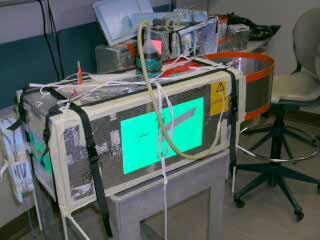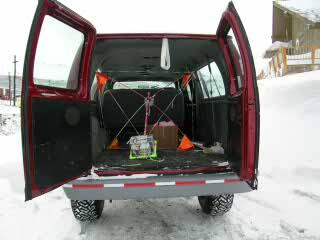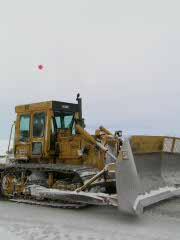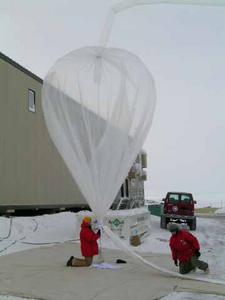24 September, 2003
Thermo-man
Today we launched the OPC (optical parcticle counter) together with Jason's thermometer. You can call him Thermo-man now because his thermometer worked all the way up to 22 kilometers until something suddenly turned off. Not bad for a first try!
The optical parcticle counter is a device that shines a very bright light onto incoming parcticles, you can think of these as tiny crystals. The light is scattered into sensitive counters called photo multiplier tubes that amplify the small amount of light so that a computer can record it. You saw a picture of those tubes in yesterday's journal.
We had extreme difficulties with the batteries. One hour before the flight they were not working. The instrument simply started for a bit then stopped. Finally something happened, we are not sure what it was, but the batteries began working again. We quickly got everything in the van and drove to the launch site. This was a slightly larger balloon so it took awhile to get the instrument assembled and the balloon inflated. The one thing in our favor today was the winds. We were launching in-between two storm systems and there was no wind at all. This gave us time to think and the balloon went off smoothly. It is very difficult for me to take pictures during a launch because I have my hands on the balloon and we do not want any sharp objects around that can tear it. Everyone must take off watches and jewelry and zippers have to be secure.
The OPC flight was very interesting; it may show that larger parcticles are still in the stratosphere at this time of year. That would be a surprising result. But the data must be analyzed closely first.
The flight landed on Black Island, not too far from here, but it likely landed on rocks, not sea ice. It will be fun to recover it later.
Well, I want to say thanks to the schools that parcticipated in the Solar Noon project. I hope you are able to figure out the circumference of the Earth. Sorry to say, I could not get any shadow here today. I will try again tomorrow, even if it is the wrong day, the shadow should be close to the same size.

The OPC with Jason's thermometer inside the box.

Packing the van in a rush to catch a lull in the winds once the instrument has gone through its final checklist.

Right in the middle of doing everything a snow plow comes by, you can see the pink pilot ball in the distance.

Testing the telemetry of the instrument. It must be able to send a signal by radio to the base station.

The balloon is large so that it can carry the extra weight. It is held down by the "weigh-off" a collection of bolts and rocks that equal the weight of the instrument and balloon.

Hooking the load onto the balloon, one minute after this the balloon was in the air.

Data, it all comes down to numbers.
Contact the TEA in the field at
.
If you cannot connect through your browser, copy the
TEA's e-mail address in the "To:" line of
your favorite e-mail package.
|
